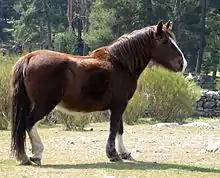Hispano-Bretón
The Hispano-Bretón is a Spanish breed of horse developed by crossing native Pura Raza Española horses with imported Breton draught horses. The breed is found mainly in two separate areas of northern Spain: Castile and León and parts of neighboring Cantabria; and the Pyrenees of Catalonia. The Hispano-Bretón is listed in the Catálogo Oficial de Razas de Ganado de España in the group of autochthonous breeds in danger of extinction. [1] The scientific work titled “Morphological and genetic characterization of Spanish heavy horse breeds: Implications for their conservation” was written by M.D. Gómez, P.J. Azor, M.E. Alonso, J. Jordana, and M. Valera. The already introduced scientific paper suggests that the ecologically important rural areas in Spain have been conserved by the Spanish heavy horses and one of such breeds is the Hispano-Breton heavy horse breed. The creation of the Hispano-Breton breed was the result of the Spanish Military Cavalry services using Spanish Breton stallions, which have been regularly produced from the Spanish draught horse populations since the 1960s. Similarly, the increase in the body size of the Native Spanish horse breeds was led by the interest in obtaining draught horses for agricultural and military purposes. Towards the end of the 20th century, the technological advancements at that point in time led to a dramatic decrease in the Spanish heavy horse population and some of those horse populations disappeared while others were used to produce horse meat. Consequently, the Spanish government has considered the Hispano-Breton heavy horse breed as an endangered breed alongside with both the Jaca Navarra and the Burguete horse breeds. The three Spanish heavy horse breeds just mentioned, as the study suggests, “make up about 90% of the total number of horses slaughtered in Spain nowadays.” The north of Castilla-Leon in Spain, usually the south side of the Cantabrian mountain range, is where the Hispano-Breton breed is located today. The Hispano-Breton breed was officially recognized in 1960 while the breed's stud book was set in 1998. It has been reported that there are 6307 animals from this breed. As the study suggests, “the main problems are the small population size and genetic degeneration, with the consequent future loss of diversity. Therefore, the most immediate and effective conservation priorities would be (1) to avoid inbreeding within populations, (2) to increase the population size, and (3) to facilitate genetic exchange among the populations.” The already mentioned study was conducted to learn how to save the Hispano-Breton endangered sub-breeds alongside other Spanish heavy horse breeds. And it determined that the Hispano-Breton from Castilla-Leon, Spain displayed the highest average of measurements for, as listed in the study, “the traits related to body width: depth, width and perimeter of thorax, width of chest, body length and cannon perimeter.” The study required a total of 426 horses from six Spanish heavy horse populations, which, as the study states, “[correspond] to the four main heavy horse breeds Hispano-Breton … with most animals located in three areas: Burgos, León, and Palencia … Jaca Navarra, Burguete and the Cavall Pirinenc Català were analyzed using 22 body measurements, 10 indices calculated from the body measurements and 16 microsatellite markers.” It is important to mention that in the previously mentioned study concluded that the Hispano-Breton breeds from both Burgos, Spain and from Palencia, Spain accounted for the Spanish heavy breeds with the lowest body indices related to meat production in both males and females. This study also concluded that the Hispano-Breton breed from Castilla-Leon, Spain has a great body size difference from the other Spanish heavy horse breeds analyzed during this study. However, these breeds also showed the highest body indices for meat production. And lastly, the Hispano-Breton heavy horse breed from Castilla-Leon, Spain has received economic funding to express its genetic background since it has been considered the subpopulation of heavy horse breeds that represents the Hispano-Breton heavy horse breed the most.

See also
References
- "Ganaderia: Clasificación de Razas". Ministerio de Medio Ambiente y Medio Rural y Marino. (in Spanish). Archived from the original on 26 March 2010. Retrieved 4 April 2011.